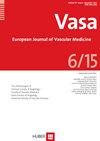外周动脉疾病患者主要心血管和肢体不良事件的预测因素和模型。
摘要
背景:外周动脉疾病(PAD)与主要不良心血管和肢体事件的风险增加相关。然而,影响PAD患者主要不良心血管事件(MACE)和主要不良肢体事件(MALE)的因素尚不清楚。此外,虽然已经开发了一些PAD患者MACE和MALE的预测模型,但其性能尚不确定。本系统综述旨在确定影响PAD患者MACE和MALE的因素,并系统评价现有的预测模型。材料和方法:我们在PubMed、Embase和Cochrane图书馆进行了文献检索,以确定探讨MACE和MALE危险因素的研究,以及这些结果的预测模型。数据提取侧重于研究设计、患者人口统计学、报告的影响因素(如临床、生化)和预测模型的特征(如变量、验证方法、性能指标)。我们使用PROBAST(预测模型偏倚风险评估工具)等已建立的工具专门评估了已确定的预测模型的方法学质量和偏倚风险。本研究旨在综合MACE和MALE决定因素的证据,并批判性地评估现有的预测模型,为未来的研究和临床决策提供信息。结果:116项研究报告了影响PAD患者MACE的因素。6项研究开发或验证了预测模型。三个模型被评为在所有领域具有低偏倚风险,而其他三个模型在至少一个领域具有不明确或高偏倚风险。共确定了118个与MACE相关的影响因素。共同因素包括:人口统计学特征(年龄、吸烟);(2)合并症(糖尿病(DM)、冠心病(CAD)、既往中风、心力衰竭);(3)临床指标(体重指数(BMI)、收缩压(SBP));(4)诊断指标(踝臂指数(ABI)、肾小球滤过率(eGFR)、c反应蛋白(CRP)、血清肌酐);(5)药物使用(他汀类药物);(6)分类系统(卢瑟福分类、方丹分类)。55项研究报告了影响PAD患者男性的因素。6项研究开发或验证了预测模型。三个模型被评为在所有领域具有低偏倚风险,而其他三个模型在至少一个领域具有不明确或高偏倚风险。共确定了88个影响因素。大多数研究的共同因素包括人口统计学特征(年龄、吸烟、社会经济地位)、合并症(糖尿病、慢性肾病、高血压、脑血管疾病)、临床因素(虚弱程度、BMI)、诊断指标(血红蛋白、血清肌酐、血清白蛋白)、药物使用(他汀类药物)和其他因素(伤口、缺血和足部感染(WIfI)分类、老年营养风险指数(GNRI))。结论:基于这些发现,我们得出结论,尽管对PAD患者MACE和MALE的影响因素进行了大量研究,但在研究设计(患者人群)、外部因素(医疗环境)和研究重点方面仍存在显著差异。我们的综述对PAD患者MACE和MALE的预测模型进行了简明而全面的分析,确定了关键的预测因素,系统地评估了这些模型,并提出了改进建议。Background: Peripheral arterial disease (PAD) is associated with an increased risk of major adverse cardiovascular and limb events. However, the factors influencing major adverse cardiovascular events (MACE) and major adverse limb events (MALE) in patients with PAD remain unclear. Additionally, while some predictive models for MACE and MALE in patients with PAD have been developed, their performance is uncertain. This systematic review aims to identify the factors influencing MACE and MALE in patients with PAD and to systematically evaluate existing predictive models. Materials and methods: We conducted a literature search in PubMed, Embase, and the Cochrane Library to identify studies exploring risk factors for MACE and MALE, as well as predictive models for these outcomes. Data extraction focused on study design, patient demographics, reported influencing factors (e.g., clinical, biochemical), and characteristics of predictive models (e.g., variables, validation methods, performance metrics). We specifically evaluated the methodological quality and risk of bias of the identified predictive models using established tools such as PROBAST (Prediction model Risk Of Bias ASsessment Tool). This study aimed to synthesize evidence on determinants of MACE and MALE and critically appraise existing prediction models to inform future research and clinical decision-making. Results: One hundred and sixteen studies reported factors influencing MACE in patients with PAD. Six studies developed or validated predictive models. Three models were rated as having low risk of bias across all domains, while the other three had unclear or high risk of bias in at least one domain. A total of 118 influencing factors associated with MACE were identified. Common factors included: demographic characteristics (age, smoking); (2) comorbidities (diabetes mellitus (DM), coronary artery disease (CAD), prior stroke, heart failure); (3) clinical measures (body mass index (BMI), systolic blood pressure (SBP)); (4) diagnostic indicators (ankle-brachial index (ABI), estimated glomerular filtration rate (eGFR), C-reactive protein (CRP), serum creatinine); (5) medication use (statins); and (6) classification systems (Rutherford classification, Fontaine classification). Fifty-five studies reported factors influencing MALE in patients with PAD. Six studies developed or validated predictive models. Three models were rated as having low risk of bias across all domains, while the other three had unclear or high risk of bias in at least one domain. A total of 88 influencing factors were identified. Common factors across most studies included demographic characteristics (age, smoking, socioeconomic status), comorbid conditions (DM, chronic kidney disease, hypertension, cerebrovascular disease), clinical factors (degree of frailty, BMI), diagnostic indicators (hemoglobin, serum creatinine, serum albumin), medication use (statin), and other factors (Wound, Ischemia, and foot Infection (WIfI) classification, geriatric nutritional risk index (GNRI)). Conclusions: Building on these findings, we conclude that, although substantial research exists on factors influencing MACE and MALE in patients with PAD, significant variability persists in study design (patient population), external factors (healthcare environment), and research focus. Our review provides a concise yet comprehensive analysis of predictive models for MACE and MALE in patients with PAD, identifies key predictive factors, systematically evaluates these models, and offers recommendations for their improvement.

 求助内容:
求助内容: 应助结果提醒方式:
应助结果提醒方式:


